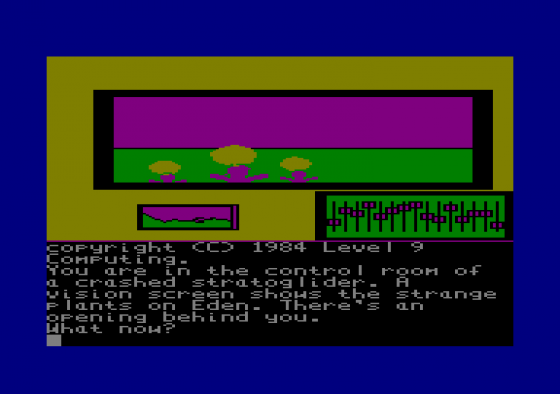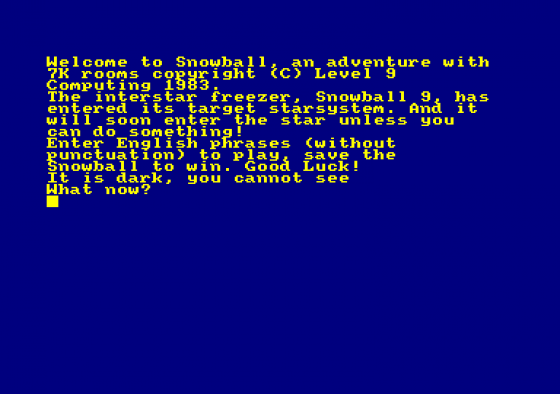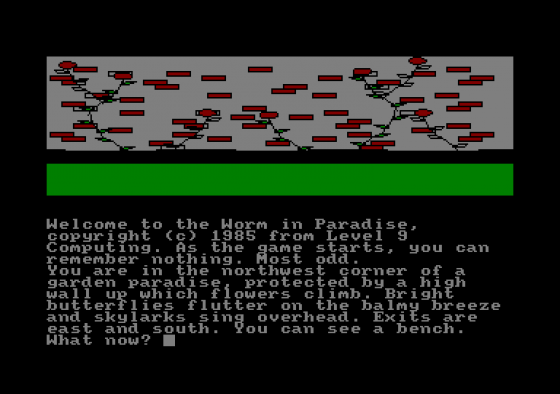
Amstrad Action
 1st February 1987
1st February 1987
Categories: Review: Software
Author: The Pilgrim
Publisher: Rainbird
Machine: Amstrad CPC464
Published in Amstrad Action #17
Silicon Dreams
OK, my friends, here's your starter for ten:
What offers you "over 600 illustrations, over 13 million locations, a huge 1800-word vocabulary, ultra-fast response times, a new language interpreter, multi-command sentences, type-ahead and multi-tasking"?
Answer: The latest press release from Rainbird Software.
Yes sir, this press release, in which Rainbird publicity merchants discuss their latest Level 9 blockbuster, Silicon Dreams, is so fraught with fact, so packed with detail, that it could almost be an adventure in itself. Is this trilogy really that stupendous? Let's examine the record...
-
"Over 600 illustrations"
Yup, 'tis true, fellow Pilgs. The three games tally well over the 600 mark altogether. However, my feelings about Level 9 graphics are well known - I really don't think they're terribly good. Level 9 argues that, without them, its games wouldn't get a look-in in the British market which has been dominated by piccies ever since The Hobbit. There's a grain of truth in this, but Infocom doesn't seem to have much trouble. Surely the answer is to polish up your adventure programming techniques rather than rely on second rate graphics to sell a game.
However, the pics are there, so no use moaning. Even Snowball, originally a true Level 9 text-only classic, has been given the dubious blessing of graphic detail. Ah, well, plus ca change - but it's not the same, in my opinion. -
"Over 13 million locations"
OK, you guessed it. What this really means is over 13 million places to go. And in case you're confused (you will be), there's a lot of difference between a place to go and a location. A location is a unique place with a unique description that has a character all of its own - be it a broom cupboard or the Casino in Worm In Paradise.
So what's a "place to go"? Well, in Worm In Paradise the luckless player must cope with the Eden transport system, which offers literally millions of destinations. Each of these destinations is colour-coded, but they don't offer you anything particularly different to all the others and certainly can't be considered as locations. The best guide to locations in this case is the number of graphics - "over 600" - since there's a piccy for every place. -
"Huge 1800-word vocabulary"
Yes, we'll let them have that one, though I'm tempted to think that a large number of words included in this aren't going to help much with actually playing the game. If anyone who's cracked all three games could count the actual number of words needed to finish the game, I'd reckon that it would be under 200. The remainder will either get you some form of "That's just scenery" message, or be otherwise unproductive. Still, this is standard practice with adventures, so I'm not complaining. -
"Ultra-fast response times."
I didn't actually notice these while playing. I suppose that's because they were so quick. -
"New language interpreter"
More about this below. -
"Multi-command sentences"
I should think so too. This is 1987, not 1066. Even GAC gives you multi-command sentences. -
"Type-ahead and multi-tasking".
If they hadn't bothered with the graphics, we wouldn't need the multi-tasking, which enables you to input text while the picture is drawing. Really, to call this multi-tasking (on an 8-bit machine like the Amstrad) is a bit much - all it does is make the computer first draw a bit of picture then check to see if you've typed anything, then draw another bit of picture. In other words, dare I say it, the program is running in some ways even slower than it would otherwise (just watch those piccies struggle onto the screen). Multi-tasking-schmasking, Level 9!
No, what's really important about this collection are the following points: first, you get all three games in one wallop, which at the price is a good deal if you haven't got any of them.
Second, you get RAM RESTORE, RAMSAVE and OOPS (which enables you go back one move). At least, you do on the 6128 - I wasn't able to check up on the 464 version.
Thirdly, you get some enhanced location descriptions. Level 9 has tarted up all three games somewhat, though on playing them I didn't really think that this had made any real improvement. The games were quite good enough as they were, especially Snowball.
More to the point, here is what you don't get. All those high-sounding features and reprogramming simply disguise the fact that these adventures are already beginning to look long in the tooth. They are programmed according to yesterday's rules. The "new language interpreter" simply does things like say "That's just scenery" if you ask about an otherwise irrelevant object that's just been printed in a location description. It still can't handle inputs involving interaction with other characters, like "Kim Kimberley, where are we?"
And that has to be the way forward with adventures. We've had years collecting treasure and battling with Orcs - now we'd like to do some good ol' interacting on the human-to-human level.
This package is a triumph of reduced-cost re-packaging. It's great value and I fully recommend it on that basis. However, if I were Level 9, I wouldn't be releasing more than one new title in 1987. I'd be spending the rest of the time changing my programming tactics, introducing interactive characters, taking advantage of the increased storage space on disks, and either abandoning or polishing up my graphics.
Otherwise 1988 will be the year Level 9 goes under...
The Three Games
Silicon Dreams is a trilogy of games concerning man's efforts to colonise the planet Eden. They all feature robots, hi-tech gadgetry and a certain amount of Level 9 philosophising about matters political and ecological. Each game has a unique character, from Snowball giving one of the best-conceived "I'm in a space-ship" scenarios ever to Return To Eden's extraordinary wildlife, including a kleptomaniac parrot and some very odd plants.
Snowball
The game that thrilled a thousand journalists when it was first released, Snowball was so popular that it was even serialised in a major (but now defunct) weekly publication. As Kim Kimberley (female) you awake on board the giant spaceship Snowball to find that the voyage to Eden, prospective new home for humanity, is going badly wrong. You have to set things right.
Snowball is a difficult game. First you have to take careful note of the colour-coded locations, and secondly the actual shape of the ship itself makes mapping difficult. And some of the puzzles are fiendish. However, it's brilliantly designed and remains one of the milestones in Level 9's history as Britain's best adventure house.
Return To Eden
Return To Eden has you struggling through the jungle to reach the city of Enoch, prepared in advance for the human colonists by robot constructors. Unfortunately the defence robots in the city have got the idea that the Snowball spaceship is an invader rather than the home of their new colonists, so good ol' Kim must leap into action once more and stop them destroying it.
The game has some very enjoyable scenes especially in the Eden jungle. It also has a rather tricky beginning, in which you have been sentenced to death in error by your fellow colonists and must escape destruction. Twill take most people quite some time to work this one out...
The Worm In Paradise
The Worm In Paradise is the most recent offering of the three. It's also the game where (to start with, at any rate) the reprogramming is least evident. The action takes place 100 years after the death of Kim Kimberley when you awake from an artificially induced dream to find out that you've forgotten who you are.
From being an out-of-work drifter you must progress first to employment, and then to membership of the ruling classes. After that, whether or not you do anything to change the rather dismal life on Eden is up to you...
Other Amstrad CPC464 Game Reviews By The Pilgrim
Scores
Amstrad CPC464 Version| Atmosphere | 85% |
| Interaction | 82% |
| Challenge | 89% |
| Overall | 88% |












